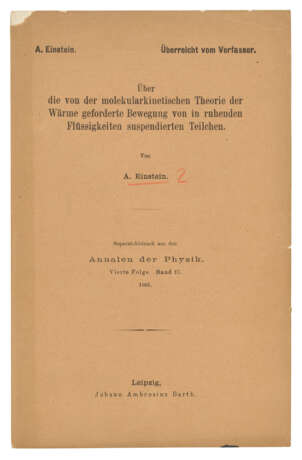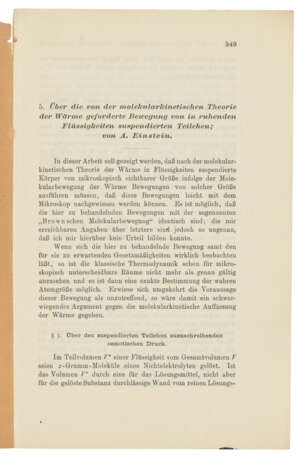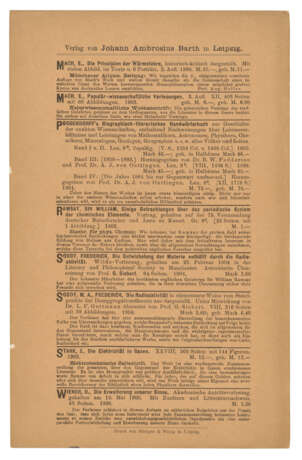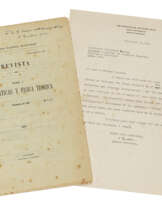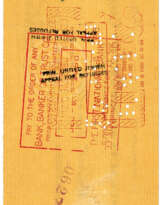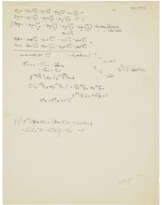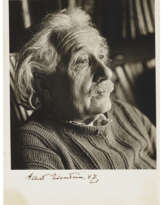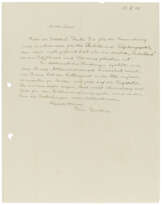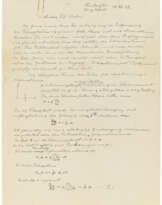ID 1349797
Lot 149 | EINSTEIN, Albert (1879-1955)
Estimate value
£ 70 000 – 100 000
'Über die von der molekularkinetischen Theorie der Wärme geforderte Bewegung von in ruhenden Flüssigkeiten suspendierten Teilchen.' Offprint from: Annalen der Physik, 4th Series, vol. 17. Leipzig: Johann Ambrosius Barth, 1905.
Very rare first edition, author's offprint issue, of Einstein’s seminal 1905 paper on Brownian motion, from the library of pioneering theoretical physicist Arnold Sommerfeld (1868-1951).
Published during Einstein’s annus mirabilis of 1905, at a time when the existence of atoms was still hotly debated, this paper addressed the phenomenon of Brownian motion—the random movement of particles suspended in a fluid, named after the botanist Robert Brown who first described it in 1827. Einstein provided a mathematical description of this motion, explaining it as the result of collisions between the suspended particles and the molecules of the fluid. He developed predictions for Brownian motion that were verified through experimentation by Jean Perrin in 1908, settling the dispute around John Dalton’s atomic theory and earning Perrin a Nobel Prize in 1926. The impact of Einstein’s paper was profound and far-reaching, providing a mathematical framework which became foundational in the study of stochastic processes, influencing fields beyond physics such as biology, chemistry, and economics.
Arnold Sommerfeld was a German theoretical physicist who made significant contributions to atomic and quantum physics. He extended Niels Bohr's atomic model by introducing elliptical orbits for electrons and proposed additional quantum numbers, including the azimuthal and magnetic quantum numbers. Sommerfeld also introduced the fine-structure constant, contributed to X-ray wave theory, and co-discovered the Sommerfeld-Wilson quantization rules. His seminal work Atombau und Spektrallinien became a foundational text for the new generation of physicists developing atomic and quantum physics. Sommerfeld was an exceptional educator, mentoring 7 Nobel Prize winners and numerous other prominent physicists. Despite being nominated for the Nobel Prize a record 84 times, he never received the award. Nevertheless, he was honoured with several prestigious accolades, including the Lorentz Medal, the Max-Planck Medal, and the Oersted Medal, and was elected to numerous scientific academies worldwide. In 1918, Sommerfeld succeeded Einstein as chair of the Deutsche Physikalische Gesellschaft, and in 1922 Einstein wrote to his successor: ‘What I especially admire about you is that you have, as it were, pounded out of the soil such a large number of young talents’ (A. Pais, ‘Subtle is the Lord...’: The Science and Life of Albert Einstein, 1982).
This author's offprint can be distinguished from the normal 'trade' edition by the statement 'Überreicht vom Verfasser' on the wrapper. Extremely rare; we have not been able to trace any copy selling at auction (RBH/ABSAA). BRL8; Weil *8.
Octavo (222 x 142mm). Paginated 549-560. Original printed wrappers (a few trivial nicks to edges, tiny unobtrusive ink stain to lower edge throughout, faint discolouration at edges, small loss to top left corner of upper wrapper with associated 11mm tear into blank margin of opening text leaf). Provenance: Arnold Sommerfeld (1868-1951; red chinagraph underlining and numbering to upper wrapper).
| Artist: | Albert Einstein (1879 - 1955) |
|---|---|
| Place of origin: | Western Europe, Germany, Europe |
| Auction house category: | Books and manuscripts, Printed books |
| Artist: | Albert Einstein (1879 - 1955) |
|---|---|
| Place of origin: | Western Europe, Germany, Europe |
| Auction house category: | Books and manuscripts, Printed books |
| Address of auction |
CHRISTIE'S 8 King Street, St. James's SW1Y 6QT London United Kingdom | |
|---|---|---|
| Preview |
| |
| Phone | +44 (0)20 7839 9060 | |
| Buyer Premium | see on Website | |
| Conditions of purchase | Conditions of purchase |
